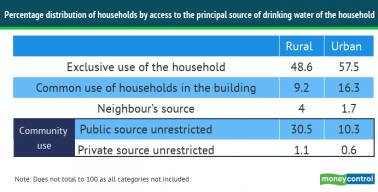



Aakanksha Arora and Aasheerwad Dwivedi
COVID-19 is challenging the healthcare facilities across the globe. The numbers of cases are increasing at an alarming rate globally. Even in India the number of cases rose at a higher rate in last few days.
Governments are trying to reduce the ‘R0’(reproduction rate) through set of measures, among which social distancing and a complete lockdown are the most important steps. Following the experience of other countries and to contain the pandemic at an early stage, India initiated a 21-day lockdown.
The government also placed a lot of importance on spreading information about the benefit of hand washing via public service announcements (PSAs) on caller tunes, advertisements in newspapers, etc.
The coronavirus threat is deeply-linked to WASH (Water, Sanitation and Hygiene) practices as advised by World Health Organization (WHO). At the micro level, the basic hygiene-related habit, access to water supply and housing facilities play a very crucial role in fighting the pandemic, along with the macro-level steps taken by the government. There is universal similarity in the macro management of the threat, but at the micro level, the conditions are very different. The NSS report on Drinking Water, Sanitation, Hygiene and Housing Condition in India of 2018 and the Key Indicators of Social Consumption in India: Health of 2017-18 shows the enormous challenge before us.
Continuous availability of clean drinking water is not only necessary for existence but a key to fighting the pathogen. Data shows that only about 58.2 percent of the households in the rural areas and about 80.7 percent of the households in the urban areas have drinking water facilities within the household premises. This means more than 40 percent of people in rural areas have to step out of their house to get drinking water, which creates a risk of increased interaction.
Out of the households which have to go out to fetch water in rural areas, 30 percent have a water source within 0.2 km and 3 percent have to walk more than 0.5 km. The farther people have to walk, the greater is the risk of coming in contact with more people. Further, 72 percent of households in rural areas store water for only one day and less than 3 percent households store for three or more days; making it necessary to step out of the house to fetch water daily. In urban areas, 60 percent people store water for less than a day.
Only 48.6 percent of households have exclusive access to the principal source of drinking water, and 33 percent of households have community access — out of which more than 30 percent are unrestricted public sources. The corresponding ratio of households in urban areas is substantially lower with around 19 percent households having a water source outside the premises, within which 11 percent are using water from unrestricted community sources. This clearly means that for significant part of the rural population staying put is not just a way of life because of challenging conditions of water availability.

Regular hand washing for 20 seconds is the recommended protection against the threat of infection. Around 70 percent of households in rural area and 42 percent in urban areas wash hands only with water before a meal. Even after defecation, around 15 percent households in rural areas reported washing hands only with water. This is a serious cause of concern as hand washing with soap is important for protecting oneself from infections. It takes a long time to change habits, but the government have done well by nudging people through PSAs.

At a time when social distancing is crucial, availability of space is essential to flattening of curve. Experts say that older people have a higher risk of getting infected. In rural India, 13.4 percent live with their spouses—in urban areas this is 15.5 percent. In rural areas nearly 79 percent live with spouses and other members or children—in urban areas this is nearly 80 percent. This is a double-edged sword as living with family members gives a sense of security, but it also creates an increased risk of infection.
The data clearly shows that on the basis of WASH practices, rural areas are placed weaker than the urban areas to face the COVID-19 threat.
Aakanksha Arora is Deputy Director, Ministry of Finance and Aasheerwad Dwivedi is Assistant Professor, Shri Ram College of Commerce, New Delhi. Views are personal.
Discover the latest Business News, Sensex, and Nifty updates. Obtain Personal Finance insights, tax queries, and expert opinions on Moneycontrol or download the Moneycontrol App to stay updated!
Find the best of Al News in one place, specially curated for you every weekend.
Stay on top of the latest tech trends and biggest startup news.